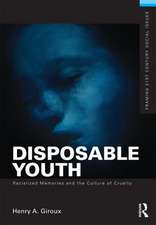Reading Rodney King/Reading Urban Uprising
Editat de Robert Gooding-Williamsen Limba Engleză Paperback – 19 apr 1993
| Toate formatele și edițiile | Preț | Express |
|---|---|---|
| Paperback (1) | 374.59 lei 22-36 zile | +22.93 lei 5-11 zile |
| Taylor & Francis – 19 apr 1993 | 374.59 lei 22-36 zile | +22.93 lei 5-11 zile |
| Hardback (1) | 1008.53 lei 43-57 zile | |
| Taylor & Francis – 19 apr 1993 | 1008.53 lei 43-57 zile |
Preț: 374.59 lei
Nou
Puncte Express: 562
Preț estimativ în valută:
71.68€ • 75.03$ • 59.66£
71.68€ • 75.03$ • 59.66£
Carte disponibilă
Livrare economică 10-24 martie
Livrare express 21-27 februarie pentru 32.92 lei
Preluare comenzi: 021 569.72.76
Specificații
ISBN-13: 9780415907354
ISBN-10: 0415907357
Pagini: 284
Dimensiuni: 152 x 229 x 21 mm
Greutate: 0.46 kg
Ediția:1
Editura: Taylor & Francis
Colecția Routledge
Locul publicării:Oxford, United Kingdom
ISBN-10: 0415907357
Pagini: 284
Dimensiuni: 152 x 229 x 21 mm
Greutate: 0.46 kg
Ediția:1
Editura: Taylor & Francis
Colecția Routledge
Locul publicării:Oxford, United Kingdom
Notă biografică
Robert Gooding-Williams is Associate Professor of Philosophy and Black Studies at Amherst College. He is author of the forthcoming book Nietszche's Pursuit of Modernism, to be published by Routledge.
Recenzii
". . . very impressive . . . These works are not about race and urban uprising. They are about all of us, not the American Dream but the American Real." -- The San Diego Review
"The book Reading Rodney King/Reading Urban Uprising offers a timely reminder that the beating of Rodney King, the outcome of the Simi Valley trial of the police officers involved in it, and the subsequent uprisings in response to the verdict are best understood in social, cultural, economic, and political contexts. The authors demonstrate that a critical analysis of popular representations of these events can illuminate the larger subject of race relations in American society. The book suggests that a multidisciplanary approach is needed to appreciate fully the vast and interlocking dimensions of the problem." -- Gail Lee Dubrow, Journal of the American Planning Association
"The book Reading Rodney King/Reading Urban Uprising offers a timely reminder that the beating of Rodney King, the outcome of the Simi Valley trial of the police officers involved in it, and the subsequent uprisings in response to the verdict are best understood in social, cultural, economic, and political contexts. The authors demonstrate that a critical analysis of popular representations of these events can illuminate the larger subject of race relations in American society. The book suggests that a multidisciplanary approach is needed to appreciate fully the vast and interlocking dimensions of the problem." -- Gail Lee Dubrow, Journal of the American Planning Association
Cuprins
Introduction[Robert Gooding-Williams; partOne Beating Black Bodies; Chapter 1 Endangered/Endangering: Schematic Racism and White Paranoia, Judith Butler; Chapter 2 Terror Austerity Race Gender Excess Theater, Ruth Wilson Gilmore; Chapter 3 Scene … Not Heard, Houston A. Baker; partTwo Acquitting White Brutality; Chapter 4 The Rules of the Game, Patricia J. Williams; Chapter 5 Reel Time/Real Justice, Kimberlé Crenshaw, Gary Peller; partThree Assaulting America: A Political Economy Begets Ruin; Chapter 6 Race, Capitalism, and the Antidemocracy, Cedric J. Robinson; Chapter 7 Accumulation as Evisceration: Urban Rebellion and the New Growth Dynamics, Rhonda M. Williams; Chapter 8 The Los Angeles “;Race Riot” and Contemporary U.S. Politics, Michael Omi, Howard Winant; partFour On the Streets of Los Angeles; Chapter 9 Anatomy of a Rebellion: A Political-Economic Analysis, Melvin L. Oliver; Chapter 10 Uprising and Repression in L.A., Houston A. Baker; partFive Ideology, Race, and Community; Chapter 11 “;Look, a Negro!”, Robert Gooding-Williams; Chapter 12 The New Enclosures: Racism in the Normalized Community, Thomas L. Dumm; Chapter 13 Korean Americans vs. African Americans: Conflict and Construction, Sumi K. Cho; partSix The Fire This Time; Chapter 14 Home is Where the HanIs: A Korean American Perspective on the Los Angeles Upheavals, Elaine H. Kim; Chapter 15 Reflections on the Rodney King Verdict and the Paradoxes of the Black Response, Jerry G. Watts; Chapter 16 Two Nations … Both Black; Chapter 17 Learning to Talk of Race;
























